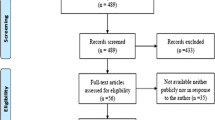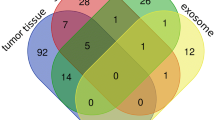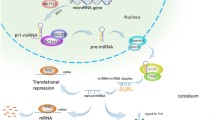Abstract
MicroRNAs (miRNAs), a class of small noncoding RNAs, regulate protein-coding gene expression by repressing translation or cleaving RNA transcripts in a sequence-specific manner. A growing body of evidence suggests that miRNAs contribute to bladder cancer development, progression and metastasis. Genome-wide miRNA expression signatures have been used to rapidly and precisely identify aberrant miRNA expression in bladder cancer. Based on reports describing miRNA signatures, several downregulated and upregulated miRNAs have been discovered. Examination of the differential expression of miRNAs between clinical bladder cancer and normal bladder tissue has led to the elucidation of 11 miRNA expression signatures. miRNAs downregulated in bladder cancer, such as miR-145, miR-143 and miR125b, are known to be tumour suppressors, whereas upregulated miRNAs, such as miR-183, miR-96, miR17-5p and miR-20a are oncogenic. Several studies have demonstrated the potential of miRNAs for providing prognostic information. miR-145 is the most frequently downregulated miRNA in bladder cancer and has been shown to significantly inhibit proliferation, migration and invasion. Understanding the role of differentially expressed miRNAs, as well as their molecular targets, in bladder cancer will provide an effective and promising strategy for miRNA-based therapeutics for the treatment of bladder cancer.
Key Points
-
Most clinical trials of chemotherapeutics for advanced bladder cancer have shown limited benefits, so new prognostic markers and effective treatment strategies are necessary
-
Examination of the differential expression of microRNAs (miRNAs) between clinical bladder cancer and normal bladder tissue has led to the elucidation of 11 bladder-cancer-specific miRNA expression signatures
-
miRNAs frequently observed in bladder cancer might be the driver molecules for cancer progression
-
Although some miRNAs might be promising prognostic markers, the results are somewhat inconsistent, and measurement of expression levels of miRNAs has not been standardized across studies
-
miRNAs have been shown to be involved in crucial cell mechanisms, such as apoptosis, the cell cycle and epithelial–mesenchymal transition
-
Dysregulation of signalling pathways downstream of miR-145 has been implicated in the progression of bladder cancer

Similar content being viewed by others
References
Parkin, D. M., Bray, F., Ferlay, J. & Pisani, P. Global cancer statistics, 2002. CA Cancer J. Clin. 55, 74–108 (2005).
Ferlay, J., Parkin, D. M. & Steliarova-Foucher, E. Estimates of cancer incidence and mortality in Europe in 2008. Eur. J. Cancer 46, 765–781 (2010).
Zuiverloon, T. C. et al. Markers predicting response to bacillus Calmette-Guérin immunotherapy in high-risk bladder cancer patients: a systematic review. Eur. Urol. 61, 1245–1256 (2012).
Luke, C., Tracey, E., Stapleton, A. & Roder, D. Exploring contrary trends in bladder cancer incidence, mortality and survival: implications for research and cancer control. Intern. Med. J. 40, 357–362 (2010).
Meeks, J. J. et al. A systematic review of neoadjuvant and adjuvant chemotherapy for muscle-invasive bladder cancer. Eur. Urol. 62, 523–533 (2012).
Shirodkar, S. P. & Lokeshwar, V. B. Potential new urinary markers in the early detection of bladder cancer. Curr. Opin. Urol. 19, 488–493 (2009).
Nelson, K. M. & Weiss, G. J. MicroRNAs and cancer: past, present, and potential future. Mol. Cancer Ther. 7, 3655–3660 (2008).
Filipowicz, W., Bhattacharyya, S. N. & Sonenberg, N. Mechanisms of post-transcriptional regulation by microRNAs: are the answers in sight? Nat. Rev. Genet. 9, 102–114 (2008).
Esquela-Kerscher, A. & Slack, F. J. Oncomirs—microRNAs with a role in cancer. Nat. Rev. Cancer 6, 259–269 (2006).
Catto, J. W. et al. MicroRNA in prostate, bladder, and kidney cancer: a systematic review. Eur. Urol. 59, 671–681 (2011).
Youssef, Y. M. et al. Accurate molecular classification of kidney cancer subtypes using microRNA signature. Eur. Urol. 59, 721–730 (2011).
Carthew, R. W. & Sontheimer, E. J. Origins and mechanisms of miRNAs and siRNAs. Cell 136, 642–655 (2009).
Bartel, D. P. MicroRNAs: genomics, biogenesis, mechanism, and function. Cell 116, 281–297 (2004).
Rodriguez, A. et al. Identification of mammalian microRNA host genes and transcription units. Genome Res. 14, 1902–1910 (2004).
Lee, Y. et al. MicroRNA genes are transcribed by RNA polymerase II. EMBO J. 23, 4051–4060 (2004).
Cai, X., Hagedorn, C. H. & Cullen, B. R. Human microRNAs are processed from capped, polyadenylated transcripts that can also function as mRNAs. RNA 10, 1957–1066 (2004).
O'Kelly, F. et al. MicroRNAs as putative mediators of treatment response in prostate cancer. Nat. Rev. Urol. 9, 397–407 (2012).
Gregory, R. I. & Shiekhattar, R. MicroRNA biogenesis and cancer. Cancer Res. 65, 3509–3512 (2005).
He, L. & Hannon, G. J. MicroRNAs: small RNAs with a big role in gene regulation. Nat. Rev. Genet. 5, 522–531 (2004).
Rand, T. A., Petersen, S., Du, F. & Wang, X. Argonaute2 cleaves the anti-guide strand of siRNA during RISC activation. Cell 123, 621–629 (2005).
Orom, U. A., Nielsen, F. C. & Lund, A. H. MicroRNA-10a binds the 5'UTR of ribosomal protein mRNAs and enhances their translation. Mol. Cell. 30, 460–471 (2008).
Tay, Y., Zhang, J., Thomson, A. M., Lim, B. & Rigoutsos, I. MicroRNAs to Nanog, Oct4 and Sox2 coding regions modulate embryonic stem cell differentiation. Nature 455, 1124–1128 (2008).
Yang, H. et al. Evaluation of genetic variants in microRNA-related genes and risk of bladder cancer. Cancer Res. 68, 2530–2537 (2008).
Teo, M. T. et al. The role of microRNA-binding site polymorphisms in DNA repair genes as risk factors for bladder cancer and breast cancer and their impact on radiotherapy outcomes. Carcinogenesis 33, 581–586 (2012).
Calin, G. A. et al. Frequent deletions and down-regulation of micro-RNA genes miR15 and miR16 at 13q14 in chronic lymphocytic leukemia. Proc. Natl Acad. Sci. USA 99, 15524–15529 (2002).
Calin, G. A. & Croce, C. M. MicroRNA signatures in human cancers. Nat. Rev. Cancer 6, 857–866 (2006).
Davis, B. N. & Hata, A. microRNA in cancer: the involvement of aberrant microRNA biogenesis regulatory pathways. Genes Cancer 1, 1100–1114 (2010).
Mavrakis, K. J., Leslie, C. S. & Wendel, H. G. Cooperative control of tumor suppressor genes by a network of oncogenic microRNAs. Cell Cycle 10, 2845–2849 (2011).
Inui, M., Martello, G. & Piccolo, S. MicroRNA control of signal transduction. Nat. Rev. Mol. Cell Biol. 11, 252–263 (2010).
Ory, B. & Ellisen, L. W. A microRNA-dependent circuit controlling p63/p73 homeostasis: p53 family cross-talk meets therapeutic opportunity. Oncotarget 2, 259–264 (2011).
Noonan, E. J., Place, R. F., Basak, S., Pookot, D. & Li, L. C. miR-449a causes Rb-dependent cell cycle arrest and senescence in prostate cancer cells. Oncotarget 1, 349–358 (2010).
Erkan, E. P., Breakefield, X. O. & Saydam, O. miRNA signature of schwannomas: possible role(s) of “tumor suppressor” miRNAs in benign tumors. Oncotarget 2, 265–270 (2011).
Nair, V. S., Maeda, L. S. & Ioannidis, J. P. Clinical outcome prediction by microRNAs in human cancer: a systematic review. J. Natl Cancer Inst. 104, 528–540 (2012).
University of Manchester miRBase [online], (2013).
Chen, Y. H. et al. Characterization of microRNAs expression profiling in one group of Chinese urothelial cell carcinoma identified by Solexa sequencing. Urol. Oncol. 31, 219–227 (2013).
Han, Y. et al. MicroRNA expression signatures of bladder cancer revealed by deep sequencing. PLoS ONE 6, e18286 (2011).
Yoshino, H. et al. The tumour-suppressive function of miR-1 and miR-133a targeting TAGLN2 in bladder cancer. Br. J. Cancer 104, 808–818 (2011).
Catto, J. W. et al. Distinct microRNA alterations characterize high- and low-grade bladder cancer. Cancer Res. 69, 8472–8481 (2009).
Dyrskjøt, L. et al. Genomic profiling of microRNAs in bladder cancer: miR-129 is associated with poor outcome and promotes cell death in vitro. Cancer Res. 69, 4851–4860 (2009).
Wang, G. et al. Up-regulation of microRNA in bladder tumor tissue is not common. Int. Urol. Nephrol. 42, 95–102 (2010).
Ichimi, T. et al. Identification of novel microRNA targets based on microRNA signatures in bladder cancer. Int. J. Cancer 125, 345–352 (2009).
Hanke, M. et al. A robust methodology to study urine microRNA as tumor marker: microRNA-126 and microRNA-182 are related to urinary bladder cancer. Urol. Oncol. 28, 655–661 (2010).
Friedman, J. M. et al. The putative tumor suppressor microRNA-101 modulates the cancer epigenome by repressing the polycomb group protein EZH2. Cancer Res. 69, 2623–2629 (2009).
Lin, T. et al. MicroRNA-143 as a tumor suppressor for bladder cancer. J. Urol. 181, 1372–1380 (2009).
Gottardo, F. et al. Micro-RNA profiling in kidney and bladder cancers. Urol. Oncol. 25, 387–392 (2007).
Noguchi, S. et al. MicroRNA-143 functions as a tumor suppressor in human bladder cancer T24 cells. Cancer Lett. 307, 211–220 (2011).
Villadsen, S. B. et al. The miR-143/-145 cluster regulates plasminogen activator inhibitor-1 in bladder cancer. Br. J. Cancer 106, 366–374 (2012).
Ostenfeld, M. S. et al. miR-145 induces caspase-dependent and -independent cell death in urothelial cancer cell lines with targeting of an expression signature present in Ta bladder tumors. Oncogene 29, 1073–1084 (2010).
Huang, L. et al. MicroRNA-125b suppresses the development of bladder cancer by targeting E2F3. Int. J. Cancer 128, 1758–1769 (2011).
Kawakami, K. et al. The functional significance of miR-1 and miR-133a in renal cell carcinoma. Eur. J. Cancer 48, 827–836 (2012).
Nohata, N. et al. Identification of novel molecular targets regulated by tumor suppressive miR-1/miR-133a in maxillary sinus squamous cell carcinoma. Int. J. Oncol. 39, 1099–1107 (2011).
Kojima, S. et al. Tumour suppressors miR-1 and miR-133a target the oncogenic function of purine nucleoside phosphorylase (PNP) in prostate cancer. Br. J. Cancer 106, 405–413 (2012).
Nohata, N., Hanazawa, T., Enokida, H. & Seki, N. microRNA-1/133a and microRNA-206/133b clusters: dysregulation and functional roles in human cancers. Oncotarget 3, 9–21 (2012).
Lin, Y. et al. Cyclin-dependent kinase 4 is a novel target in microRNA-195-mediated cell cycle arrest in bladder cancer cells. FEBS Lett. 586, 442–447 (2012).
Xu, C. et al. miRNA-100 inhibits human bladder urothelial carcinogenesis by directly targeting mTOR. Mol. Cancer Ther. 12, 207–219 (2013).
Zhou, Y. et al. MicroRNA-133 inhibits cell proliferation, migration and invasion by targeting epidermal growth factor receptor and its downstream effector proteins in bladder cancer. Scand. J. Urol. http://dx.doi.org/10.3109/00365599.2012.748821.
Mihelich, B. L. et al. miR-183-96-182 cluster is overexpressed in prostate tissue and regulates zinc homeostasis in prostate cells. J. Biol. Chem. 286, 44503–44511 (2011).
Zhu, W. et al. Overexpression of members of the microRNA-183 family is a risk factor for lung cancer: a case control study. BMC Cancer 11, 393 (2011).
Myatt, S. S. et al. Definition of microRNAs that repress expression of the tumor suppressor gene FOXO1 in endometrial cancer. Cancer Res. 70, 367–377 (2010).
Liu, Y. et al. Synthetic miRNA-mowers targeting miR-183-96-182 cluster or miR-210 inhibit growth and migration and induce apoptosis in bladder cancer cells. PLoS ONE 7, e52280 (2012).
He, L. et al. A microRNA polycistron as a potential human oncogene. Nature 435, 828–833 (2005).
Calin, G. A. et al. Human microRNA genes are frequently located at fragile sites and genomic regions involved in cancers. Proc. Natl Acad. Sci. USA 101, 2999–3004 (2004).
Yamada, Y. et al. MiR-96 and miR-183 detection in urine serve as potential tumor markers of urothelial carcinoma: correlation with stage and grade, and comparison with urinary cytology. Cancer Sci. 102, 522–529 (2011).
Puerta-Gil, P. et al. miR-143, miR-222, and miR-452 are useful as tumor stratification and noninvasive diagnostic biomarkers for bladder cancer. Am. J. Pathol. 180, 1808–1815 (2012).
Wiklund, E. D. et al. Coordinated epigenetic repression of the miR-200 family and miR-205 in invasive bladder cancer. Int. J. Cancer 128, 1327–1334 (2011).
Veerla, S. et al. MiRNA expression in urothelial carcinomas: important roles of miR-10a, miR-222, miR-125b, miR-7 and miR-452 for tumor stage and metastasis, and frequent homozygous losses of miR-31. Int. J. Cancer 124, 2236–2242 (2009).
Yoshino, H. et al. Tumor suppressive microRNA-1 mediated novel apoptosis pathways through direct inhibition of splicing factor serine/arginine-rich 9 (SRSF9/SRp30c) in bladder cancer. Biochem. Biophys. Res. Commun. 417, 588–593 (2012).
Chiyomaru, T. et al. Functional role of LASP1 in cell viability and its regulation by microRNAs in bladder cancer. Urol. Oncol. 30, 434–443 (2012).
Cao, Y. et al. MicroRNA-dependent regulation of PTEN after arsenic trioxide treatment in bladder cancer cell line T24. Tumour Biol. 32, 179–188 (2011).
Lodygin, D. et al. Inactivation of miR-34a by aberrant CpG methylation in multiple types of cancer. Cell Cycle 7, 2591–2600 (2008).
Chiyomaru, T. et al. miR-145 and miR-133a function as tumour suppressors and directly regulate FSCN1 expression in bladder cancer. Br. J. Cancer 102, 883–891 (2010).
Fei, X. et al. MicroRNA-195-5p suppresses glucose uptake and proliferation of human bladder cancer T24 cells by regulating GLUT3 expression. FEBS Lett. 586, 392–397 (2012).
Adam, L. et al. miR-200 expression regulates epithelial-to-mesenchymal transition in bladder cancer cells and reverses resistance to epidermal growth factor receptor therapy. Clin. Cancer Res. 15, 5060–5072 (2009).
Kenney, P. A. et al. Novel ZEB1 expression in bladder tumorigenesis. BJU Int. 107, 656–663 (2011).
Bo, J. et al. microRNA-203 suppresses bladder cancer development by repressing bcl-w expression. FEBS J. 278, 786–792 (2011).
Saini, S. et al. Curcumin modulates microRNA-203-mediated regulation of the Src-Akt axis in bladder cancer. Cancer Prev. Res. (Phila.) 4, 1698–1709 (2011).
Chen, H. et al. MicroRNA-449a acts as a tumor suppressor in human bladder cancer through the regulation of pocket proteins. Cancer Lett. 320, 40–47 (2012).
Ueno, K. et al. Tumor suppressor microRNA-493 decreases cell motility and migration ability in human bladder cancer cells by downregulating RhoC and FZD4. Mol. Cancer Ther. 11, 244–253 (2012).
Hirata, H. et al. MicroRNA-1826 targets VEGFC, beta-catenin (CTNNB1) and MEK1 (MAP2K1) in human bladder cancer. Carcinogenesis 33, 41–48 (2012).
Lu, Q. et al. MicroRNA-221 silencing predisposed human bladder cancer cells to undergo apoptosis induced by TRAIL. Urol. Oncol. 28, 635–641 (2010).
Gómez-Román, J. J. et al. Fibroblast growth factor receptor 3 is overexpressed in urinary tract carcinomas and modulates the neoplastic cell growth. Clin. Cancer Res. 11, 459–465 (2005).
Huber, M. A., Kraut, N. & Beug, H. Molecular requirements for epithelial-mesenchymal transition during tumor progression. Curr. Opin. Cell Biol. 17, 548–558 (2005).
Xu, J., Lamouille, S. & Derynck, R. TGF-beta-induced epithelial to mesenchymal transition. Cell Res. 19, 156–172 (2009).
Zaman, M. S. et al. The functional significance of microRNA-145 in prostate cancer. Br. J. Cancer 103, 256–264 (2010).
Schepeler, T. et al. Diagnostic and prognostic microRNAs in stage II colon cancer. Cancer Res. 68, 6416–6424 (2008).
Iorio, M. V. et al. MicroRNA signatures in human ovarian cancer. Cancer Res. 67, 8699–8707 (2007).
Kano, M. et al. miR-145, miR-133a and miR-133b: tumor suppressive miRNAs target FSCN1 in esophageal squamous cell carcinoma. Int. J. Cancer 127, 2804–2814 (2010).
Akao, Y., Nakagawa, Y., Kitade, Y., Kinoshita, T. & Naoe, T. Downregulation of microRNAs-143 and -145 in B-cell malignancies. Cancer Sci. 98, 1914–1920 (2007).
Wang, L. et al. Gene networks and microRNAs implicated in aggressive prostate cancer. Cancer Res. 69, 9490–9497 (2009).
Sachdeva, M. & Mo, Y. Y. miR-145-mediated suppression of cell growth, invasion and metastasis. Am. J. Transl. Res. 2, 170–180 (2010).
Altuvia, Y. et al. Clustering and conservation patterns of human microRNAs. Nucleic Acids Res. 33, 2697–2706 (2005).
Baskerville, S. & Bartel, D. P. Microarray profiling of microRNAs reveals frequent coexpression with neighboring miRNAs and host genes. RNA 11, 241–247 (2005).
Aqeilan, R. I., Calin, G. A. & Croce, C. M. miR-15a and miR-16-1 in cancer: discovery, function and future perspectives. Cell Death Differ. 17, 215–220 (2010).
Olive, V., Jiang, I. & He, L. mir-17-92, a cluster of miRNAs in the midst of the cancer network. Int. J. Biochem. Cell Biol. 42, 1348–1354 (2010).
Iio, A., Nakagawa, Y., Hirata, I., Naoe, T. & Akao, Y. Identification of noncoding RNAs embracing microRNA-143/145 cluster. Mol. Cancer 9, 136 (2010).
Wang, Y. & Lee, C. G. MicroRNA and cancer–focus on apoptosis. J. Cell. Mol. Med. 13, 12–23 (2009).
Dostalova Merkerova, M. et al. Distinctive microRNA expression profiles in CD34+ bone marrow cells from patients with myelodysplastic syndrome. Eur. J. Hum. Genet. 19, 313–319 (2011).
Suzuki, H. I. et al. Modulation of microRNA processing by p53. Nature 460, 529–533 (2009).
Sachdeva, M. et al. p53 represses c-Myc through induction of the tumor suppressor miR-145. Proc. Natl Acad. Sci. USA 106, 3207–3212 (2009).
Adhikary, S. & Eilers, M. Transcriptional regulation and transformation by Myc proteins. Nat. Rev. Mol. Cell Biol. 6, 635–645 (2005).
Levy, N., Yonish-Rouach, E., Oren, M. & Kimchi, A. Complementation by wild-type p53 of interleukin-6 effects on M1 cells: induction of cell cycle exit and cooperativity with c-myc suppression. Mol. Cell Biol. 13, 7942–7952 (1993).
Boominathan, L. The guardians of the genome (p53, TA-p73, and TA-p63) are regulators of tumor suppressor miRNAs network. Cancer Metastasis Rev. 29, 613–639 (2010).
Author information
Authors and Affiliations
Contributions
H. Yoshino and N. Seki contributed equally to the discussion of content and writing of this article. H. Yoshino, T. Itesako and T. Chiyomaru researched data for the article. H. Enokida contributed to discussion of content. H. Enokida, N. Seki and M. Nakagawa reviewed the manuscript before submission.
Corresponding author
Ethics declarations
Competing interests
The authors declare no competing financial interests.
Supplementary information
Supplementary Table 1
Differentially expressed miRNAs in bladder cancer (DOC 53 kb)
Rights and permissions
About this article
Cite this article
Yoshino, H., Seki, N., Itesako, T. et al. Aberrant expression of microRNAs in bladder cancer. Nat Rev Urol 10, 396–404 (2013). https://doi.org/10.1038/nrurol.2013.113
Published:
Issue Date:
DOI: https://doi.org/10.1038/nrurol.2013.113
- Springer Nature Limited
This article is cited by
-
MiRNA-93: a novel signature in human disorders and drug resistance
Cell Communication and Signaling (2023)
-
MiR-205-3p suppresses bladder cancer progression via GLO1 mediated P38/ERK activation
BMC Cancer (2023)
-
Mir-183 functions as an oncogene via decreasing PTEN in breast cancer cells
Scientific Reports (2023)
-
The relationship between microRNAs and bladder cancer: are microRNAs useful to predict bladder cancer in suspicious patients?
International Urology and Nephrology (2023)
-
An Overview of Angiogenesis in Bladder Cancer
Current Oncology Reports (2023)





